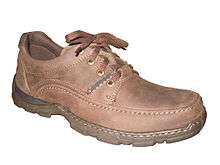Hush Puppies
 | |
| Product type | Footwear |
|---|---|
| Owner | Wolverine World Wide |
| Country | United States |
| Introduced | 1958 |
| Markets | 120 countries |
| Website |
www |


Hush Puppies is an American internationally marketed brand of contemporary, casual footwear for men, women and children. The shoes have been described as "the classic American brushed-suede shoes with the lightweight crepe sole".[1] A division of Wolverine World Wide, Hush Puppies is headquartered in Rockford, Michigan. Wolverine markets and completely licenses the Hush Puppies name for footwear in over 120 countries throughout the world. In addition, the Hush Puppies name is licensed for non-footwear fashion categories, including clothing, eyewear, plush toys and more.
Hush Puppies uses a Basset Hound named Jason as its logo which are occasionally referred to as "hush puppies" for that reason.
History
The Hush Puppies brand was founded in 1958 following extensive work by Wolverine to develop a practical method of pigskin tanning for the US military. (Pigskin is considered one of the most durable leathers and the government was interested in its use in gloves and other protective materials for soldiers.) Chairman Victor Krause developed the concept of a "casual" pigskin shoe to appeal to the then-growing post-war suburbia in the United States. The brand became instantly recognizable as a leisure casual staple of late 1950s and 1960s American life.
The Hush Puppies name and mascot were coined by the brand's first sales manager, James Gaylord Muir. Initially, the company's advertising agency recommended naming the product "Lasers". Then, on a selling trip to the southeastern United States, Muir dined with one of his regional salesmen and the meal included hush puppies, traditional, fried, southern cornballs. When Muir asked more deeply about the origin of the name, he was told that farmers threw hush puppies at the hounds to "quiet their barking dogs." Muir saw a connection to his new product. "Barking dogs" in the vernacular of the day was an idiom for sore feet. Muir surmised his new shoes were so comfortable that they could "quiet barking dogs."[2]
Hush Puppies claimed their rubber soles saved the life of Rolling Stones guitarist Keith Richards when he accidentally touched his guitar against an ungrounded microphone at a 1965 concert in Sacramento, California. Richards was knocked unconscious, but medics believed that the crepe-soled Hush Puppies shoes he was wearing insulated him and saved his life.[2]
Mid-1990s
According to The Tipping Point by journalist Malcolm Gladwell, in 1994 when sales of Hush Puppies were down to 30,000 pairs a year, and Wolverine was considering phasing out the brand, Hush Puppies suddenly became "hip" in the clubs and bars of downtown Manhattan where young people were "buying them up" at small shoe stores.[3] In the fall of 1995, fashion designers John Bartlett, Anna Sui, and Joel Fitzpatrick began featuring them in their collections. Depending on word of mouth, Wolverine sold 430,000 pairs of the shoes, and four times that the following year.[4] Hush Puppies won the prize for best accessory at the Council of Fashion Designers awards dinner in 1996.[5]
Wolverine company history [6] details this as (from 1994): 'Taking a cue from fashion designer John Bartlett, newly hired designer Maggie Mercado revived 1950s-era styles such as the "Wayne" (née Duke) oxford and "Earl" slip-on, offering the waterproof suede shoes in a rainbow of new colors such as Pepto-Bismol pink and Day-Glo green. Both Bartlett and designer Anna Sui featured the shoes in their 1995 collections. Hush Puppies soon began to turn up on the famous feet of stars such as Lady Diana, Jim Carrey, Sharon Stone, David Bowie, Tom Hanks, Dennis Rodman and Sylvester Stallone. Hush Puppies also benefited from the trend toward dressing-down at work, filling the fashion gap between tennis shoes and dress shoes. Wolverine sent videotapes with tips for casual dressing at work to 200 businesses throughout the United States. In the ultimate retro coup, the company revived the "We invented casual" tagline that had launched Hush Puppies in 1958. By 1995, tony stores such as Barneys in New York and Pleasure Swell in California struggled to keep the shoes in stock.' In providing evidence of the sales increase being due to internal changes, this source continues: 'In 1996 [Geoffrey] Bloom was rewarded for his remarkable turnaround achievement by being named chairman.'
Further evidence for internal changes being the major factor for sales improvement comes from Jeffrey L. Lewis, Director of Marketing 1992-1996 and Vice President/Director of Marketing 1996-2001 in his professional history [7] which includes '60% increase in Hush Puppies domestic footwear sales 1992-1997', 'Doubled Hush Puppies worldwide pairs 1992-1997' and (1996-2001 section) '2000% increase in suede footwear sales with a halo effect that strengthened entire line' as well as considerable other details supporting concerted and sustained sales and marketing changes.
Wolverine company public reports for early 1994 [8] detail vastly improved sales with 'Net earnings for the 16 weeks ended January 1, 1994 increased to $7.7 million, or $1.08 per share, compared to a loss of $571,000, or $0.08 per share, for the respective quarter of 1992.' The reports go on to mention Hush Puppies' contribution: 'This Hush Puppies Division reported significantly higher earnings'; 'The repositioning of our Hush Puppies brand and maximizing the continuing growth of our Wolverine Work and Outdoor Group will continue to lead the Company's earnings growth during 1994'; and 'The turnaround is behind us.'
In popular culture
The Jimmy Buffett song Come Monday included a reference to Hush Puppies.
The Oran "Juice" Jones song The Rain includes a reference to Hush Puppy shoes.
The Pete Townshend song Rough Boys includes a reference to Hush Puppy shoes.
References
- ↑ Gladwell, Malcolm (2000). The Tipping Point: How little things can make a big difference. Boston: Little, Brown and Company. p. 3. ISBN 0-316-34662-4.
- 1 2 Hush Puppies Timeline
- ↑ Gladwell, p. 3
- ↑ Gladwell, p. 4
- ↑ Gladwell, Malcolm (2006). The Tipping Point: How Little Things Can Make a Big Difference. Little, Brown and Company. ISBN 9780759574731. Retrieved June 11, 2015.
- ↑ http://www.fundinguniverse.com/company-histories/Wolverine-World-Wide-Inc-Company-History.html
- ↑ http://homepage.mac.com/footlewis/JeffLewis/LewisText012104_000.txt
- ↑ http://www.thefreelibrary.com/WOLVERINE+WORLD+WIDE+REPORTS+HIGHER+EARNINGS+AND+SALES+FOR+YEAR+AND...-a014837758
External links
- Official website—Hush Puppies.com
- Spokane Daily Chronicle—late 1960s newspaper ad for Bozos oxfords - 1968-11-14 - p. 43
